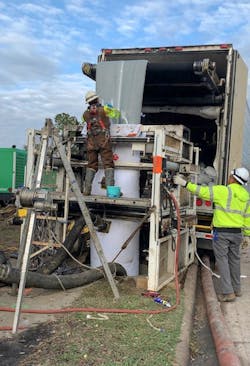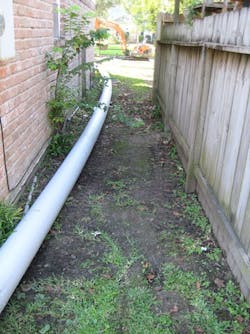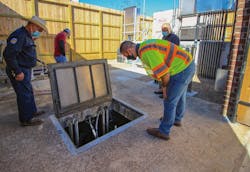10-Year Initiative: Minimizing Sanitary Sewer Overflows (SSOs)
About the author:
Kelly Shipley, P.E., is an associate and team leader at Lockwood, Andrews & Newnam Inc. (LAN), a planning, engineering and program management firm. Shipley can be reached at [email protected].
The Clear Lake City Water Authority’s (CLCWA), the largest water district in Texas, has an extensive wastewater collection system comprising 29 lift stations, 6,000 manholes, and 1.1 million linear feet of sanitary sewers. The system, which has a capacity exceeding 10 million gallons a day (mgd), serves more than 100,000 customers in the Clear Lake area.
In the 2000s, the district’s aging system started to deteriorate, leading to sanitary sewer overflows (SSOs). Subsequently, the Authority decided to address this issue and entered into a multi-year sanitary sewer overflow initiative with the Texas Commission on Environmental Quality (TCEQ). In 2009, CLCWA hired Lockwood, Andrews & Newnam Inc. (LAN), a national planning, engineering and program management firm, as district engineer to evaluate and rehabilitate its sanitary sewer system.
“The system was originally built in the 1960s and the region has also grown rapidly in the last few decades,” said Bill Rosenbaum, P.E., LAN vice president. “These two factors put a lot of stress on the system. At its worst, there were more than 30 SSOs a year.”
Two-Pronged Approach for SSOs
To tackle this issue, LAN engineers developed a two-pronged approach. The first approach immediately addressed locations that experienced a cluster of SSOs. The project team spoke with residents and analyzed sewer line reports to determine the location, type and cause of overflow, and the number of overflows in a particular line. Lines that experienced a one-time SSO due to electrical surges and lines with recurring problems were fixed immediately.
Next, LAN took a systematic approach to address long-term concerns. Each year, the project team evaluated a third of Clear Lake’s 136 subdivisions and a third of the sanitary sewer lines and manholes within each subdivision. The oldest subdivisions were inspected first, under the assumption that these sections would be the most deteriorated. Pipe material was another factor. Many subdivisions had sewer lines built with clay and cast iron, which are more susceptible to deterioration and collapse.
Using CCTV and smoke testing, the project team inspected these lines to observe leaks, breaks, grease and fat buildup, blockages, faulty connections, and other structural defects. Based on the observations, LAN gave a weighted condition assessment rating for each line and manhole. The ratings ranged from one to five, one being the best and five being the worst. For example, a pipe on the verge of collapse was rated as a five while a pipe with a hairline crack received a rating of two.
From this rating, the project team created a prioritized list of sanitary sewer lines and manholes that required rehabilitation along with the most cost-effective solution. Through this approach, more than 1 million linear feet of sanitary sewer and 5,600 manholes – 94% of the system – have been inspected to-date. More than 34% of the sewer lines have been rehabilitated based on this evaluation.
Trenchless Rehabilitation Methods & Challenges
To minimize disruption to residents and businesses, the project team primarily used a variety of trenchless technology methods to rehabilitate the prioritized sewer lines. These included cured-in-place pipe (CIPP), pipe bursting, slip lining, epoxy coating, injection grouting, and using link-seals.
“These lines were often in residents’ back yards and sometimes there would be a barn, shed or pool over them,” Rosenbaum said. “Rehabilitating the lines through open-cut methods would have been disruptive and expensive to residents. The authority prides itself on being good neighbors and taking care of its residents. So, we tried to keep the footprint as small as possible. Even when we chose a non-trenchless method, we chose the least intrusive one.”
A large portion of Clear Lake’s wastewater system consisted of small-diameter collection systems with lines made of clay. When a clay pipe cracks, a knock-on effect is created down the line. For these lines, the project team employed pipe bursting as a preferred method. Entire sections within a subdivision were rehabilitated with pipe bursting, especially the lines that were more than 50 years old. This allowed the project team to install a new pipe from manhole to manhole. In places where pipe bursting could potentially damage someone’s property, the team used another method such as CIPP or slip lining. For large diameter lines, such as a 60-inch trunk line, the project team utilized cementitious lining with an epoxy coating.
Minimizing disruption wasn’t the only challenge. Evaluating and rehabilitating such a large system with an allocated budget each year was another challenge.
“CLCWA has a great board and they see the value in upgrading and maintaining the system every year,” Rosenbaum said. “Even so, given the size of the system, we had to be selective and prioritize. We did a cost-analysis for each project. We looked at how much money we needed for pipe bursting each year and how it compared with another trenchless method. If we choose CIPP, how will the overall project cost be affected? We also tried to rehabilitate more than one subdivision at a time so we could cover as much area as possible. It was a delicate balance.”
Accessing lines buried deep under busy intersections or business and residential properties was also an issue.
“One of the sanitary sewer lines was in a section of Clear Lake with small patio homes,” Rosenbaum said. “The contractor had very little room to maneuver. So, we changed our methodology, extended the line to get an access point, and fixed it. Another line ran under a major street near a commercial driveway. We decided to CIPP that line and the contractor was able to access the properties along the street.”
Results & Current Work
Thanks to these efforts over the past 10 years, the water authority has seen a substantial decrease in wastewater influent to its treatment plant, resulting in lower operational costs and delaying the need for an expansion of the plant. The program also has significantly reduced the condition assessment rating of the sanitary lines and increased the overall life of the system. More significantly, the number of SSOs has reduced to approximately 5 to 7 every year.
While the majority of the sanitary sewer lines have been inspected and rehabilitated, the authority has also faced setbacks due to infiltration and inflow from recent tropical storms such as Imelda and Beta, resulting in SSOs. Consequently, in July 2020, CLCWA entered into another five-year sanitary sewer overflow initiative with the TCEQ. Some of the measures that are being implemented as part of this current initiative include:
- Installing flow meters at lift stations and logging the incoming flow to identify the magnitude of infiltration and inflow. The data collected will be used to determine what modifications will be necessary at these lift stations to help manage wet weather flows.
- Alleviating the gravity sanitary sewer system in subdivisions receiving excessive flows by redirecting flows from force mains to large diameter lines or the next downstream lift station.
- Installing flood mitigation measures to keep lift stations operational during heavy rain events and storms.
- Upgrading and standardizing electrical components and control panels for all lift stations to increase reliability.
- Performing regular television inspections on a sample of one-third of the system on an annual basis to identify and evaluate potential problems.
- Rehabilitating the appropriate manholes and sewer mains identified via the regular television inspections to reduce infiltration, inflow and blockages.
In addition to these measures, CLCWA is embarking on a rigorous operations and maintenance program. All 29 lift stations are visited and inspected every Monday, Wednesday, and Friday. Lift stations without communications are visited and inspected every evening and during the day on Tuesdays and Thursdays. Lift stations with communications are checked remotely every two hours, 24 hours a day for operating parameters.
These lift stations also have a system that sends texts, emails, and voicemail messages for alerts such as power outages, high wet well levels, and high pump amperage readings. Some of the SSOs in the area are caused by grease and debris and privately owned sanitary sewer service lines that are made of clay, concrete or cast iron.
To increase awareness, CLCWA is including information in utility bills on how to reduce fats, oils, grease and debris entering the system. The authority and the project team are also doing extensive community outreach to educate residents on the negative impacts of old, private service lines and the importance of replacing these lines. Where possible, the project team is replacing private service lines that are in Clear Lake’s right-of-way.
“Overall, the project is an excellent example of how to improve an aging wastewater infrastructure in an efficient, cost effective manner,” Rosenbaum.



